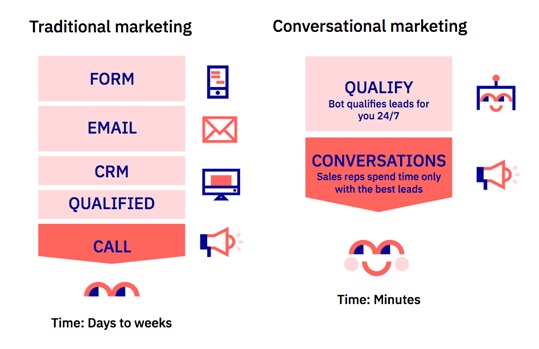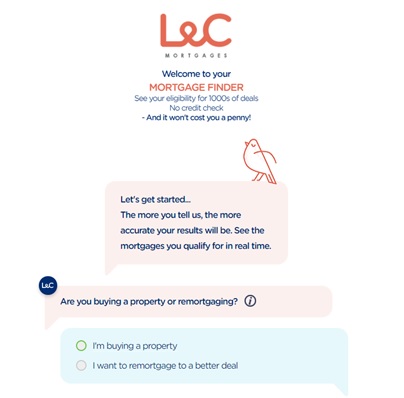Conversational marketing is a process by which customers who visit websites and who interact with marketers’ and organizations’ social media content will be engaged rigorously via a dialogue-driven approach to marketing. It can also be described as an inbound style of marketing with two focuses: consumer interactions and communication. It enables marketers to use almost any channel, such as Chabot’s personalized emails and videos, to address consumer needs. This type of consumer experience can be used in social media channels, websites, sponsored advertising, as well as in-store displays and connected home devices like Alexa.

Source: https://www.avidlyagency.com/
Conversational Marketing looks like a sales pitch, so what is the marketing strategy here? On the other hand, marketing that speaks to individuals is a relatively recent concept. Conversational marketing helps to make things that would normally be considered as marketing resources interactive. Engagement and conversion are crucial in any marketing campaign. They’re easier than ever before with conversational marketing.
So how does conversational marketing work? Here, organizations use three steps to make this happen: Engage, comprehend, and recommend. First, the marketer engages with customers who visit the marketer’s website or click through the marketer’s ad on social media. Here, marketers need to build the content to converse with customers. In the next step, marketers need to understand the queries of customers or their needs after engaging with them. Finally, the marketers need to recommend the solution, i.e., products or services, to the consumers through their conversations.
Things to do in conversational marketing
- Starting the conversation (Engage)
- Creating tools for capturing and qualifying leads-Chatbot, Live Messenger, Live Streaming Video, interactive forms, landing pages, personalized email, voice applications (such as Google Smart Assistant, Alexa,) (Understand and Recommend)
Why will it be more than a buzz in 2022?
According to a report by Forrester, 87 percent of businesses recognize that a traditional sales process is no longer sufficient to satisfy their customers. So, for those customers who demand it, conversational marketing can be a reaction. Presently, it is just a buzz and an innovation trigger for marketers, but it is going to be the trend in 2022, and there are going to be a lot of expectations and outcomes from it.
As we are aware, products and services are very important for any business. Customers’ experiences with those products or services, on the other hand, are equally important for any business. Conversational marketing helps to build that customer experience. Today, customers have many choices, and a lot of services are sold for the convenience of the customer, such as Zomato, Swiggy, and Netflix, to name a few.
So, why is conversational marketing important?
One of the important reasons why conversational marketing is important for businesses is that customers want communication or messages from marketers. It is because whenever a customer has problems or needs solutions to their queries, they require a proper reply from marketers. When these messages start to converse, they will be in the message. Also, because of the shift in technology, customers want a real-time response.
Also, interaction with customers is an opportunity for marketers. Even though customers have all the information, they still want interaction. So, to replace face-to-face conversation, conversational marketing will step in. Conversational marketing is helpful and a powerful tool for “high-involvement and complex purchases” like travel and tourism, financial services, and high-end automobiles.
Conversational sales will get leads from conversational marketing, as it helps to engage, qualify, and convert the interaction into a lead for sales. This happens because potential customers will get assistance and their queries will be herded and responded to in real time. This conversation, after dialogue, should move towards the sales team, and they will take the lead and convert it into sales.
Examples of Conversational Marketing
- Domino’s Pizza
“Order from Anywhere”

Source: Domino’s Pizza Twitter
- London and Country

Source: L and C Chatbot
- Toyota Prius Prime

Source: Advertisement of IBM – Watson- 2018
- Netflix

Source: Netflix Twitter
The above are a few examples of conversational marketing. When we look at these examples starting from Domino’s, “Order from Anywhere” is one such conversation on Twitter, which showcased their conversation marketing where text messaging is used by Domino’s. With a simple pizza emoji, they hope to entice past customers to order again. It doesn’t get any easier than this. Also, when we look at L and C’s approach, they have employed a cute Chatbot to ask qualifying questions and collect new leads from potential clients. Whereas Toyota, with respect to its car, Prius Prime, came up with a real-time engagement with clients and prospects through conversations using IBM’s conversation solutions. Also, Netflix uses social media platforms like Twitter to have regular conversations with customers, engage them frequently and learn about their needs.
In a nutshell, we can say that conversational marketing assists you in retaining old customers and maintaining relationships, as it is simpler to retain old customers than to gain new ones. Also, as of now, conversational marketing also helps to gain new customers. In the future, most organizations are expected to use this technique to satisfy and engage with customers.
Prof. Ganesha K.S
Assistant Professor,
DSCE-MBA
